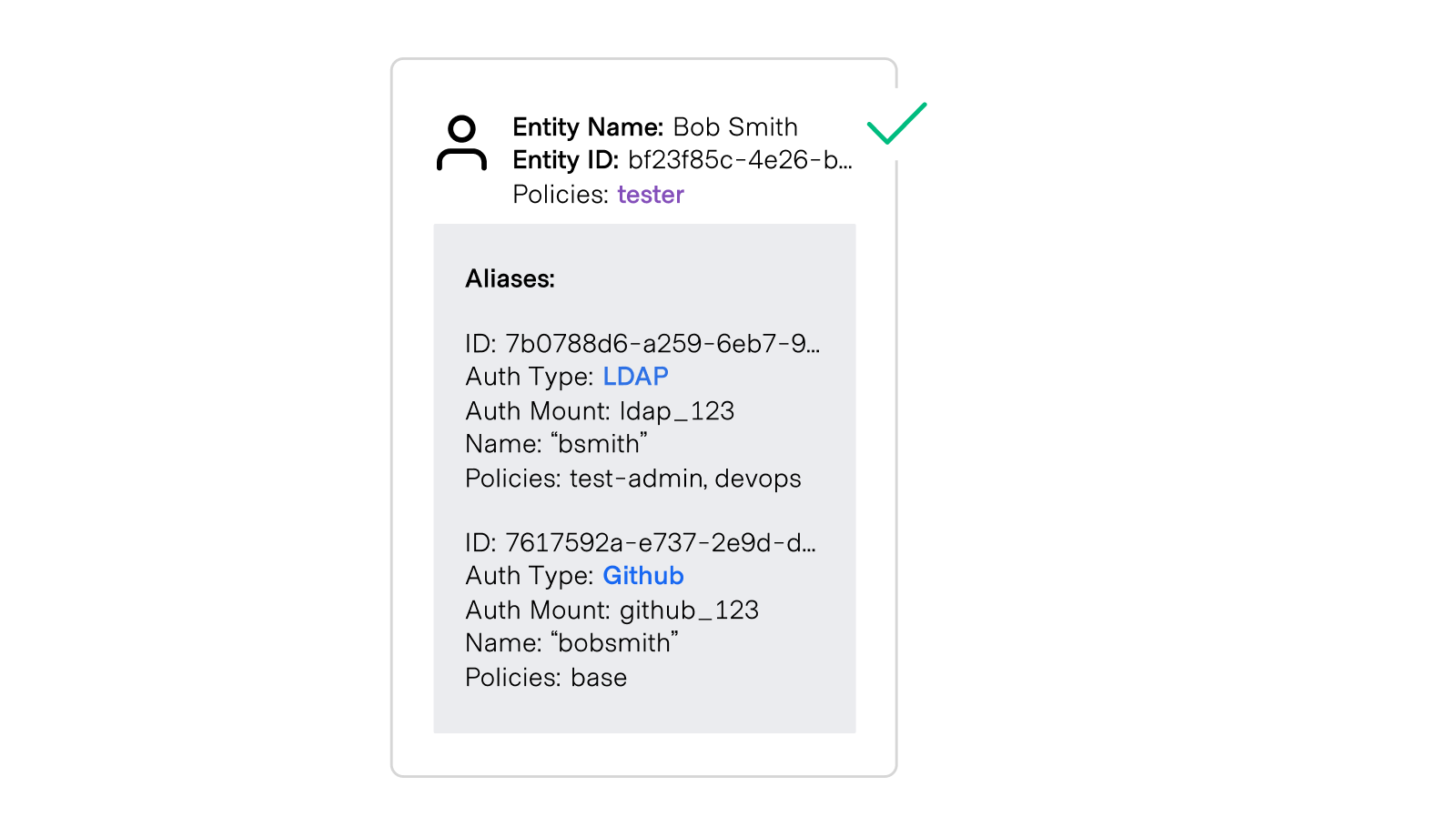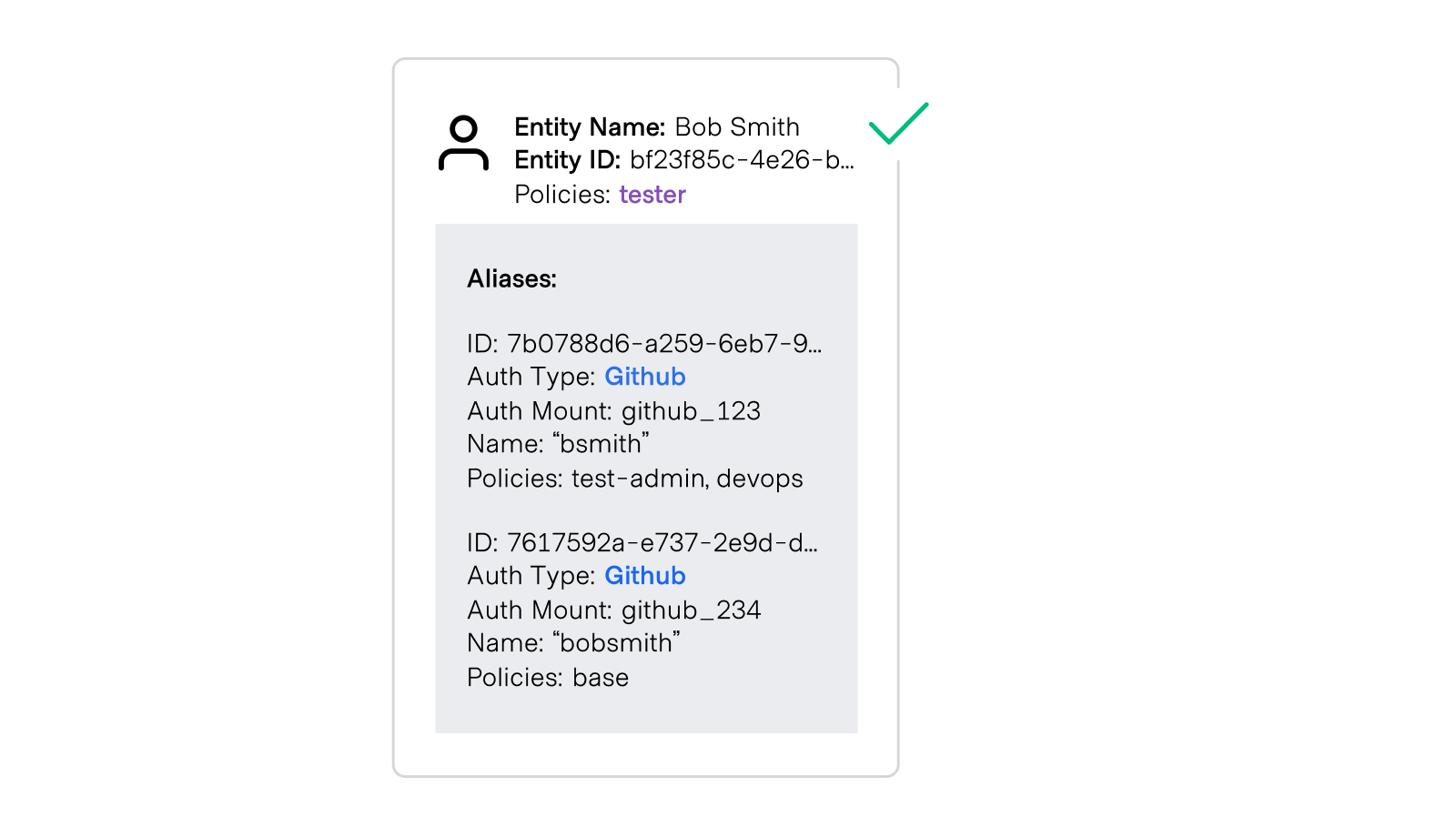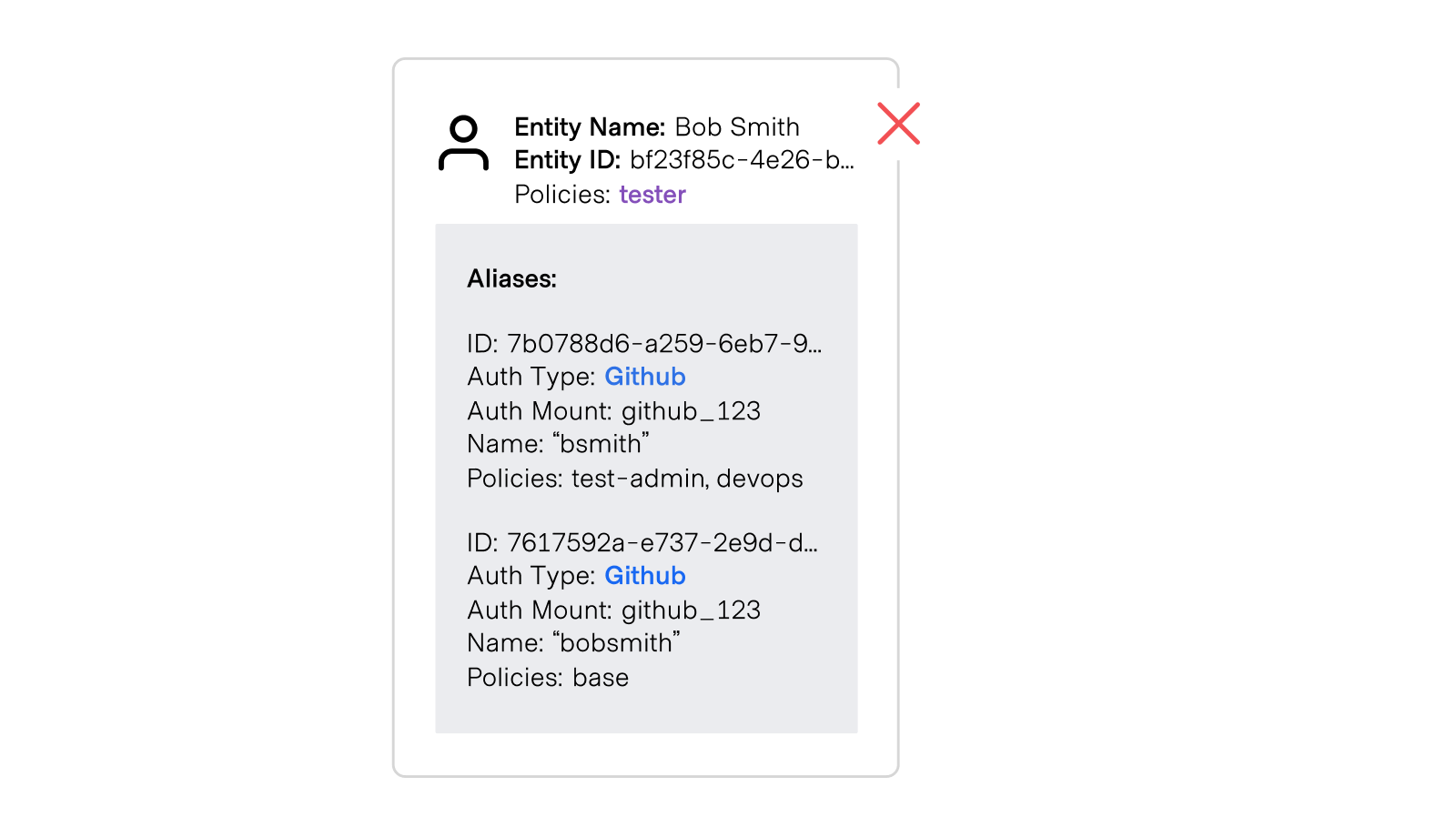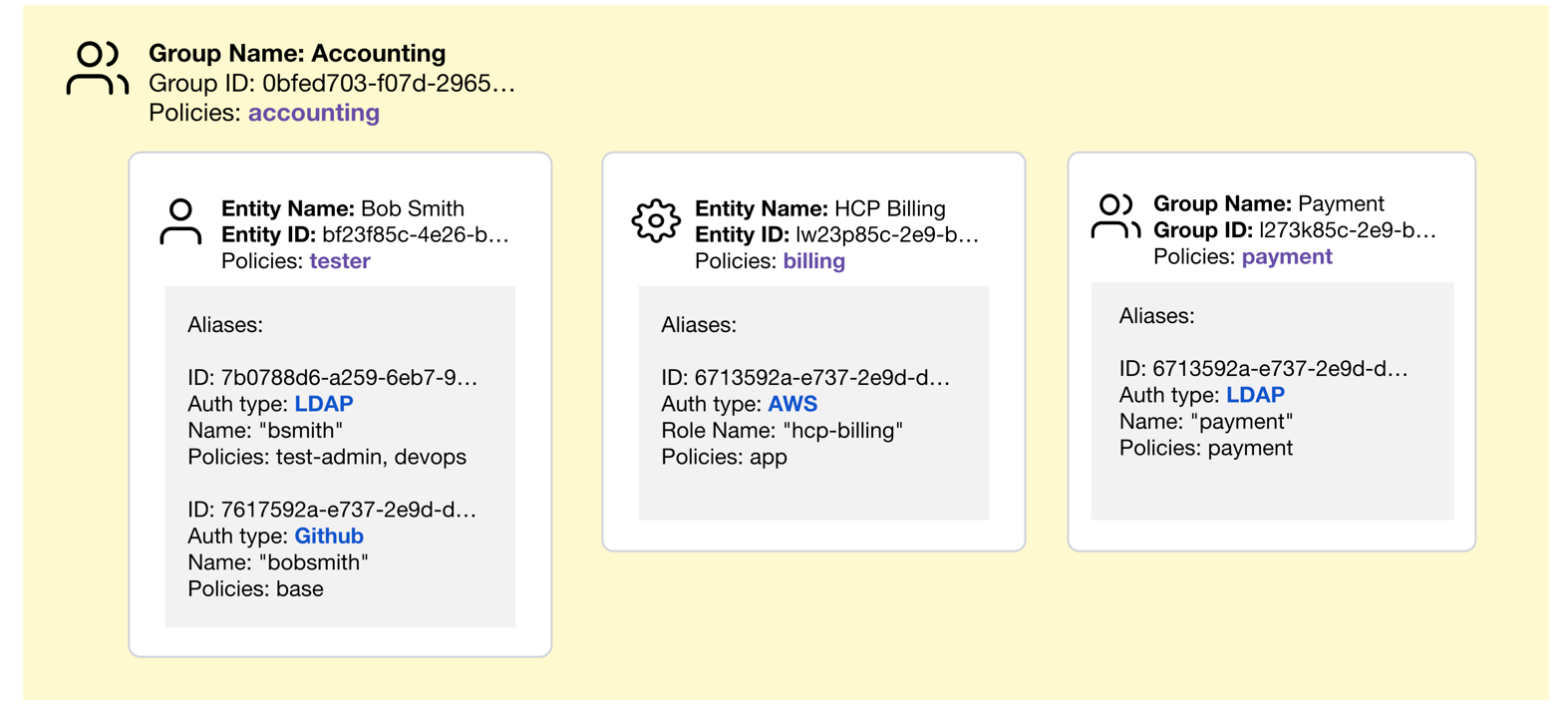Identity
This document contains conceptual information about Identity along with an overview of the various terminologies and their concepts. The idea of Identity is to maintain the clients who are recognized by OpenBao. As such, OpenBao provides an identity management solution through the Identity secrets engine. For more information about the Identity secrets engine and how it is used, refer to the Identity Secrets Engine documentation.
Entities and aliases
Each user may have multiple accounts with various identity providers, and OpenBao supports many of those providers to authenticate with OpenBao. OpenBao Identity can tie authentications from various auth methods to a single representation. This representation of a consolidated identity is called an Entity and their corresponding accounts with authentication providers can be mapped as Aliases. In essence, each entity is made up of zero or more aliases. An entity cannot have more than one alias for a particular authentication backend.
For example, a user with accounts in both GitHub and LDAP can be mapped to a single entity in OpenBao with two aliases, one of type GitHub and one of type LDAP.

However, if both aliases are created on the same auth mount, such as a Github mount, both aliases cannot be mapped to the same entity. The aliases can have the same auth type, as long as the auth mounts are different, and still be associated to the same entity. The diagrams below illustrate both valid and invalid scenarios.


When a client authenticates via any credential backend (except the Token backend), OpenBao creates a new entity. It attaches a new alias to it if a corresponding entity does not already exist. The entity identifier will be tied to the authenticated token. When such tokens are used, their entity identifiers are audit logged, marking a trail of actions performed by specific users.
Entity management
Entities in OpenBao do not automatically pull identity information from anywhere. It needs to be explicitly managed by operators. This way, it is flexible in terms of administratively controlling the number of entities to be synced against OpenBao. In some sense, OpenBao will serve as a cache of identities and not as a source of identities.
Entity policies
OpenBao policies can be assigned to entities which will grant additional permissions to the token on top of the existing policies on the token. If the token presented on the API request contains an identifier for the entity and if that entity has a set of policies on it, then the token will be capable of performing actions allowed by the policies on the entity as well.

This is a paradigm shift in terms of when the policies of the token get evaluated. Before identity, the policy names on the token were immutable (not the contents of those policies though). But with entity policies, along with the immutable set of policy names on the token, the evaluation of policies applicable to the token through its identity will happen at request time. This also adds enormous flexibility to control the behavior of already issued tokens.
It is important to note that the policies on the entity are only a means to grant additional capabilities and not a replacement for the policies on the token. To know the full set of capabilities of the token with an associated entity identifier, the policies on the token should be taken into account.
NOTE: Be careful in granting permissions to non-readonly identity endpoints. If a user can modify an entity, they can grant it additional privileges through policies. If a user can modify an alias they can login with, they can bind it to an entity with higher privileges. If a user can modify group membership, they can add their entity to a group with higher privileges.
Mount bound aliases
OpenBao supports multiple authentication backends and also allows enabling the same type of authentication backend on different mount paths. The alias name of the user will be unique within the backend's mount. But identity store needs to uniquely distinguish between conflicting alias names across different mounts of these identity providers. Hence, the alias name in combination with the authentication backend mount's accessor, serve as the unique identifier of an alias.
The table below shows what information each of the supported auth methods uses to form the alias name. This is the identifying information that is used to match or create an entity. If no entities are explicitly created or merged, then one entity will be implicitly created for each object on the right-hand side of the table, when it is used to authenticate on a particular auth mount point.
| Auth method | Name reported by auth method |
|---|---|
| AppRole | Role ID |
| JWT/OIDC | Configurable via user_claim to one of the presented claims (no default value) |
| Kerberos | Username |
| Kubernetes | Configurable via alias_name_source to one of: Service account UID (default), Service account name |
| LDAP | Username |
| RADIUS | Username |
| TLS Certificate | Subject CommonName |
| Token | entity_alias, if provided |
| Username (userpass) | Username |
Implicit entities
Operators can create entities for all the users of an auth mount beforehand and assign policies to them, so that when users login, the desired capabilities to the tokens via entities are already assigned. But if that's not done, upon a successful user login from any of the authentication backends, OpenBao will create a new entity and assign an alias against the login that was successful.
Note that the tokens created using the token authentication backend will not
normally have any associated identity information. An existing or new implicit
entity can be assigned by using the entity_alias parameter, when creating a
token using a token role with a configured list of allowed_entity_aliases.
Identity auditing
If the token used to make API calls has an associated entity identifier, it will be audit logged as well. This leaves a trail of actions performed by specific users.
Identity groups
OpenBao identity has support for groups. A group can contain multiple entities as its members. A group can also have subgroups. Policies set on the group are granted to all members of the group. During request time, when the token's entity ID is being evaluated for the policies that it has access to, policies that are inherited due to group memberships are granted along with the policies on the entity itself.

Group hierarchical permissions
Entities can be direct members of groups, in which case they inherit the policies of the groups they belong to. Entities can also be indirect members of groups. For example, if a GroupA has GroupB as subgroup, then members of GroupB are indirect members of GroupA. Hence, the members of GroupB will have access to policies on both GroupA and GroupB.
External vs internal groups
By default, the groups created in identity store are called the internal groups. The membership management of these groups should be carried out manually. A group can also be created as an external group. In this case, the entity membership in the group is managed semi-automatically. An external group serves as a mapping to a group that is outside of the identity store. External groups can have one (and only one) alias. This alias should map to a notion of a group that is outside of the identity store. For example, groups in LDAP and teams in GitHub. A username in LDAP belonging to a group in LDAP can get its entity ID added as a member of a group in OpenBao automatically during logins and token renewals. This works only if the group in OpenBao is an external group and has an alias that maps to the group in LDAP. If the user is removed from the group in LDAP, that change gets reflected in OpenBao only upon the subsequent login or renewal operation.
For information about Identity Secrets Engine, refer to Identity Secrets Engine.